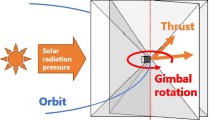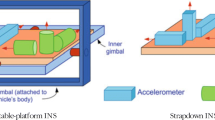Abstract
The mode of maintaining a solar orientation of spacecraft–gyrostat in low Earth orbit for a long time has been studied. The spacecraft is close to a cylinder in shape with two fixed solar arrays. The arrays are located along the longitudinal axis of the cylinder, symmetrically with respect to it. In the solar-orientation mode, the normal to the plane of the spacecraft solar arrays is invariably directed to the Sun, and the longitudinal axis oscillates relative to the plane of the orbit. To implement the specified mode of the spacecraft motion, a system of four reaction wheels is used, the rotation axes of which are directed parallel to the lateral edges of the quadrangular pyramid. The position of the lateral edges of the pyramid relative to the coordinate system rigidly connected to the spacecraft is given by two angles, which are the parameters of the reaction-wheel system. The law of control of the gyrostatic moment is considered, which ensures the attenuation of the perturbed motion of the spacecraft in the vicinity of the position of its solar orientation and limits the accumulation of the own kinetic moment of the reaction wheels by controlling the angle of rotation of the spacecraft around the normal to the light-sensitive side of the solar arrays. The study shows that with the help of a certain choice of parameters of the reaction-wheel system, it is possible to implement the solar-orientation mode without unloading the gyrostatic moment during the entire flight time. The results of numerical simulation of the complete system of equations of the spacecraft motion in the mode of its solar orientation, taking into account the influence of gravitational and aerodynamic moments, are presented, confirming the correctness of the chosen values of the parameters.












Similar content being viewed by others
REFERENCES
Ignatov, A.I. and Sazonov, V.V., Estimation of residual microaccelerations on board an artificial earth satellite in the monoaxial solar orientation mode, Cosmic Res., 2013, vol. 51, no. 5, pp. 342–349. https://doi.org/10.1134/S0010952513050055
Ignatov, A.I., Stabilization of the mode of solar orientation of an artificial satellite of the Earth without accumulation of the kinetic moment of the gyrosystem, Izv. Ross. Akad. Nauk. Teor. Sist. Upr., 2020, no. 3, pp. 164–176. https://doi.org/10.31857/S0002338820030063
Ignatov, A.I., Estimation of low-frequency microaccelerations onboard an artificial Earth satellite in the solar orientation mode, Cosmic Res., 2022, vol. 60, no. 1, pp. 38–50. https://doi.org/10.1134/S001095252201004X
Bazhinov, I.K., Gavrilov, V.P., Yastrebov, V.D., et al., Navigatsionnoe obespechenie poleta orbital’nogo kompleksa “Salyut-6”–“Soyuz”–“Progress” (Navigation Support for the Flight of the Salyut-6–Soyuz–Progress Orbital Complex), Moscow: Nauka, 1985.
Beletskii, V.V., Dvizhenie iskusstvennogo KA otnositel’no tsentra mass (Motion of an Artificial Spacecraft Relative to the Center of Mass), Moscow: Nauka, 1965.
Meeus, J., Astronomical Formulae for Calculators, Willmann-Bell, 1988.
Ignatov, A.I., Choice of geometric parameters of location of the engine-flywheel system in controlling the rotational motion of a spacecraft, Izv. Ross. Akad. Nauk. Teor. Sist. Upr., 2022, no. 1, pp. 124–144. https://doi.org/10.31857/S0002338822010061
Gantmacher, F.R., Matrix Theory, New York: Chelsea Publ., 1984.
Markley, F.L., Reynolds, R.G., and Liu, F.X., Maximum torque and momentum envelopes for reaction-wheel arrays, J. Guid., Control, Dyn., 2010, vol. 33, no. 5, pp. 1606–1614. https://doi.org/10.2514/1.47235
Yoon, H., Seo, H.H., and Choi, H.-T., Optimal uses of reaction wheels in the pyramid configuration using a new minimum infinity-norm solution, Aerosp. Sci. Technol., 2014, vol. 39, pp. 109–119. https://doi.org/10.1016/j.ast.2014.09.002
Yoon, H., Seo, H.H., Park, Y.-W., and Choi, H.-T., A new minimum infinity-norm solution: With application to capacity analysis of spacecraft reaction wheels, American Control Conf. (ACC), 2015, pp. 1241–1245.
Strang, G., Linear Algebra and Its Applications, New York: Elsevier, 1968.
Author information
Authors and Affiliations
Corresponding author
Ethics declarations
The authors declare that they have no conflicts of interest.
Additional information
Translated by N. Topchiev
Rights and permissions
About this article
Cite this article
Ignatov, A.I., Ivanov, G.A., Kolomietz, E.S. et al. Implementation of a Spacecraft Solar-Orientation Model Using a Reaction-Wheel System. Cosmic Res 61, 154–166 (2023). https://doi.org/10.1134/S0010952522700150
Received:
Revised:
Accepted:
Published:
Issue Date:
DOI: https://doi.org/10.1134/S0010952522700150




